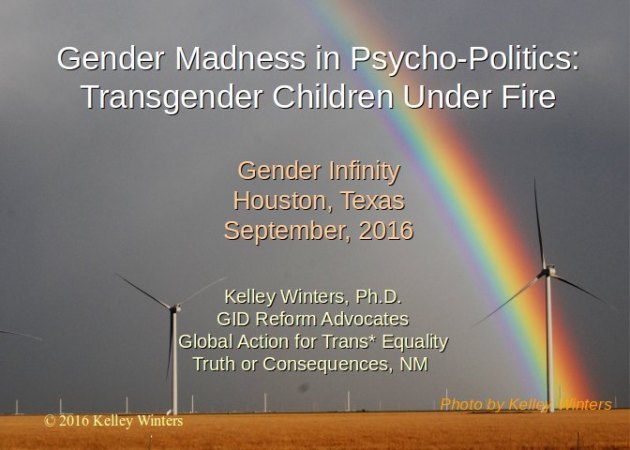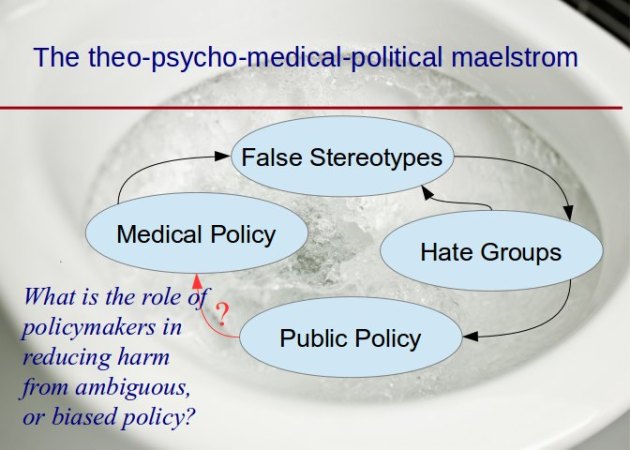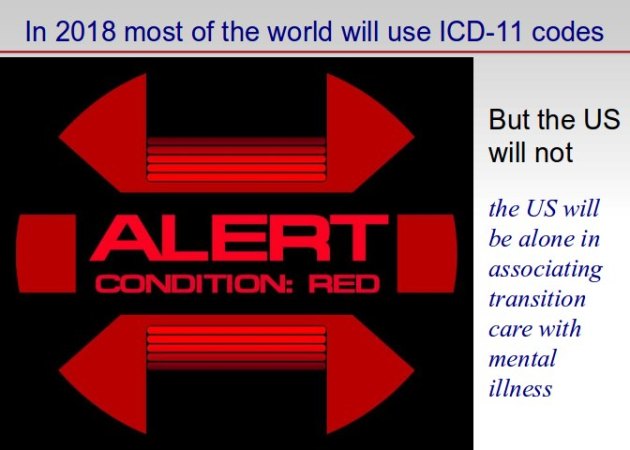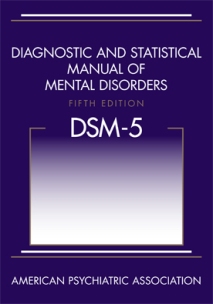Gender Madness in Psycho-Politics: Transgender Children Under Fire
September 19, 2016 1 Comment
A presentation to
Gender Infinity
Houston, Texas, USA
September, 2016
Kelley Winters, Ph.D.
GID Reform Advocates

Presentation Slides: 201609infinityg1
The Quadrumvirate of Anti-Trans Defamation:
My little taxonomy of false stereotypes about trans adults, adolescents and children, crediting the individuals responsible for searing them into public consciousness:
- Raymondian–alleging that trans women are “deceptive,” sexually “predatory” “men” whose existence poses a threat to the safety of others; and that trans men are “women” rather than authentic men. (Dr. Janice Raymond, University of Massachusetts in Amherst, 1979)
- McHughian–alleging that trans women are “delusional,” “confused,” “mentally ill” “men” (and vice-versa for trans men), and that accepting, respecting or providing transition medical care to trans people in our authentic roles represents “collaboration” with “mental disorder.” (Dr. Paul McHugh, John Hopkins University, 1979)
- Blanchardian–alleging that most trans and transsexual women are psychosexually disordered “paraphilic” “men,” motivated only by sexual deviance/fetishism. Dr. Blanchard later included trans men to this false stereotype, by adding a so-called “autoandrophilia” specifier to his “transvestic disorder” in an early draft of the DSM-5. (Dr. Ray Blanchard, Clarke Institute of Psychiatry/Centre for Addiction and Mental Health, 1989)
- Zuckerian–alleging that gender dysphoria in the great majority, around 80%, of gender dysphoric children is a passing phase that will “desist” or “remit” by adolescence. Zucker has long promoted and practiced gender conversion “therapeutic intervention,” to enforce birth-assigned gender identities and expressions. (Dr. Kenneth Zucker, Clarke Institute of Psychiatry/Centre for Addiction and Mental Health, 1989)
These stereotypes have been weaponized by political extremist groups to inflict unprecedented systemic, strategic attacks on the human rights and medical care access of trans people and especially trans children.
Strategy of Anti-Trans Political, Social and Media Attack:
Coordinated legislation, litigation and misinformation aimed at:
- Eliminating access to Public Accommodation and Education
- Eliminating gender marker correction in official Documents & Records
- Eliminating access to transition medical care
- Legalizing and promoting Gender-Conversion Psychotherapy
Architects of systemic public policy attack:
- Family Research Council–authored the blueprint for anti-trans political, social and media attacks in 2013 that has been followed by US extremists nationwide
- Southern Baptist Convention Theological Seminary
- Heritage Foundation
- Republican Party

Strategic medical policy issues for the 20-teens:
my own priority list…
- WPATH: clarify and correct the childhood “desistance” myth statement in the SOC7
- WPATH: Issue a public policy statement discrediting the practice of gender-conversion psychotherapies that is consistent with the SOC7
- APA: clarify and correct the childhood “desistance” myth statement in the DSM-5
- APA: remove “Transvestic Disorder” category from the DSM-5
- WHO: initiate substantive conversation on converging the Adult/Adolescent Gender Incongruence categories in the proposed ICD-11 with the childhood category to refute the historical stereotype of childhood gender “confusion” and practice of gender conversion psychotherapies
- US Dept. of HHS: align transition related categories in ICD-10-CM to ICD-11 in 2018
- US Dept. of HHS/CMS: issue a National Coverage Determination for surgical transition care that is recognized as medically necessary by US and international medical authorities

A Call to Action
Attention to medical policy reforms that clarify evidence, reduce harm, and benefit health and mortality is as urgent in today’s world as ever. It is an essential step in fixing society for all of the Leelah Alcorns in our midst.
References
(under construction…)
Blanchard, R. (1989) “The Classification and Labeling of Nonhomosexual Gender Dysphoria,” Archives of Sexual Behavior, v. 18 n. 4, p. 322-323.
Brennan, C. and Hungerford, .E, (2011) “2011 Letter to the UN on ‘gender identity’ legislation,” http://sexnotgender.com/gender-identity-legislation-and-the-erosion-of-sex-based-legal-protections-for-females/
Drummond, Kelley D.; Bradley, Susan J.; Peterson-Badali, Michele; Zucker, Kenneth J. (2008), “A follow-up study of girls with gender identity disorder,” Developmental Psychology. Vol 44(1), Jan 2008, 34-45.
Ford, Z. (2014) “Three Days In Nashville Talking To Southern Baptists About Homosexuality,” Think Progress, Center for American Progress. http://thinkprogress.org/lgbt/2014/10/30/3586418/southern-baptist-erlc-homosexuality/
McHugh, Paul (1992). “Psychiatric Misadventures,” The American Scholar,
Autumn, http://www.lhup.edu/~dsimanek/mchugh.htm
P. McHugh (2004) “Surgical Sex,” First Things 147:34-38, http://www.firstthings.com/ftissues/ft0411/articles/mchugh.htm , http://www.firstthings.com/article/2004/11/surgical-sex
Raymond, Janice G. (1979) The Transsexual Empire: The Making of the She-male. New York: Teachers College,
Raymond, Janice G. (1980) “Technology on the Social and Ethical Aspects of Transsexual Surgery,” http://www.susans.org/reference/usts1-9.html
Stone, Sandy (1987) THE EMPIRE STRIKES BACK: A POSTTRANSSEXUAL MANIFESTO, http://sandystone.com/empire-strikes-back
Southern Baptist Convention (2014) “On Transgender Identity,” Resolution. http://www.sbc.net/resolutions/2250/on-transgender-identity
Williams, Cristen, (2013) “TERFs & Trans Healthcare [UPDATED],” http://theterfs.com/terfs-trans-healthcare/
Winters, K. (2008) “Disallowed Identities, Disaffirmed Childhood,” GID Reform Weblog, October, https://gidreform.wordpress.com/2008/10/28/disordered-identities-disaffirmed-childhood/
Winters, K. (2008) https://gidreform.wordpress.com/2008/11/10/autogynephilia-the-infallible-derogatory-hypothesis-part-1/
Winters, K. (2008) https://gidreform.wordpress.com/2008/11/19/autogynephilia-the-infallible-derogatory-hypothesis-part-2/
Winters, K. (2008) https://gidreform.wordpress.com/2008/07/01/the-horns-of-a-false-dilemma/
Winters, K. (2012) “These Aren’t the Droids You’re Looking For: Gender Diversity, Scapegoating and Erasure in Medicine and Media,” https://gidreform.wordpress.com/2012/04/21/these-arent-the-droids-youre-looking-for-gender-diversity-scapegoating-and-erasure-in-medicine-and-media/
Winters, K. (2013) “Response to Dr. Jack Drescher and the NY Times About Childhood Transition,” GID Reform Weblog, July 5, https://gidreform.wordpress.com/category/childhood-social-transition/
Winters, K. (2014) “Methodological Questions in Childhood Gender Identity ‘Desistence’ Research,” 23rd World Professional Association for Transgender Health Biennial Symposium, reposted GID Reform Blog, Feb. 25. https://gidreform.wordpress.com/2014/02/25/methodological-questions-in-childhood-gender-identity-desistence-research/
World Professional Association for Transgender Health (2011), Standards of Care for the Health of Transsexual, Transgender, and Gender Nonconforming People: Author. http://www.wpath.org

